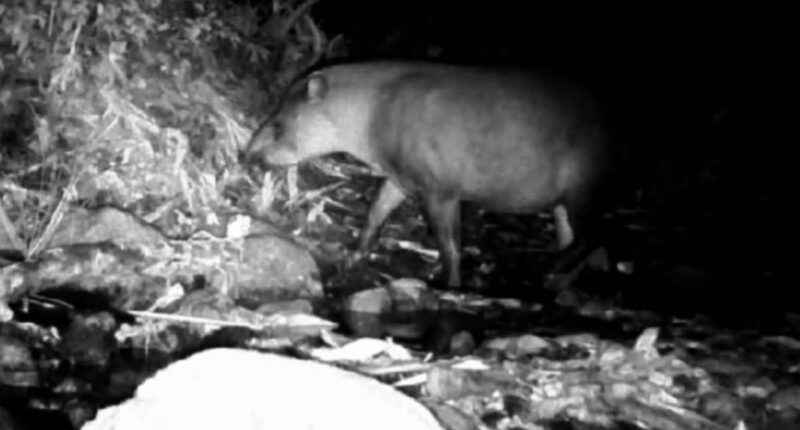A South American tapir, a species thought to be extinct, was recently spotted in Brazil, more than a century after its last sighting.
In Cunhambebe State Park, cameras hidden in the dense growth of the Atlantic Forest captured an astonishing sight: three South American tapirs, a surprising discovery.
The rhinoceros relatives were believed to have gone extinct before the unanticipated sighting in January.
The last sighting of this rare herbivore, also known as the Brazilian tapir, occurred over 100 years ago in 1914 at the Serra dos Órgãos National Park, located about 87 miles away from Cunhambebe.
A total of 108 images and videos compiled by Rio de Janeiro’s State Environmental Institute revealed the presence of three tapirs, walking through the state park.
The reappearance of the largest terrestrial mammal in South America has thrilled conservationists and scientists across the region as many consider the sighting an ‘encouraging sign.’
‘This challenge reflects the importance of protected areas and conservation efforts in the recovery of emblematic species’, an INEA spokesperson told DiarioAS.
Also known as the South American tapir, the maned tapir and the lowland tapir, the Brazilian tapir can be found in the rainforests of South America.

Over a century has passed since the last sighting of a South American tapir (pictured), a species previously believed to be extinct, until a recent, surprise sighting was reported in Brazil

Hidden cameras placed deep within the dense growth of the Atlantic Forest in Cunhambebe State Park revealed a shocking sight – three South American tapirs
The lowland tapir is just one of four species of tapir, a mammal that has been around since the Eocene era – around 35 million years ago.
The other species include Baird’s tapir, Mountain tapir and the Malayan tapir.
Populations for all four species have been steadily declining and all are classified as endangered, according to the International Union for Conservation of Nature.
Tapirs of all kinds have experienced a steep decline over the last hundred years as urbanization, deforestation and poaching threaten the dwindling population.
To make matters more dire, female maned tapirs can only conceive for two days every two to three months.
And, once pregnant, the mother tapir will carry the baby for over a year before giving birth, earning themselves a low reproductive rate and a high infant mortality rate.
A baby tapirs have brown fur with white stripes, similar to that of a fawn, to help them blend into the rain forest floor. However, their babies’ white stripes fade over time as the calves mature.

A total of 108 images and videos compiled by Rio de Janeiro’s State Environmental Institute revealed the presence of three tapirs, walking through the state park. Pictured: Wild tapirs were caught on camera in the Cunhambebe state park, in the south of the state of Rio de Janeiro

The lowland tapir is just one of four species of tapir, a mammal that has inhabited the earth since since the Eocene era – around 35 million years ago
After 18 months with the mother, a tapir calf is considered fully grown but may stay remain its mother.
In the wild, Brazilian tapirs live about 25 to 30 years.
The Brazilian tapir is more abundant than the other three species of tapir, but is still considered ‘vulnerable of extinction’ by the IUCN Red List.
The Brazilian tapir has a long and flexible snout which helps them to feed on leaves, buds, shoots, fruit, grass and aquatic plants.
They generally feed only at night, hiding in the cool forest during the day.
Weighing between 330-550 pounds, on average, according to AnimalFactGuide.com, Brazilian tapirs typically measure around 6 feet in length.
Adult Brazilian tapirs have brown coats that vary in shade, with darker hair on their sturdy legs and short, stiff manes. They also have short tails.
Brazilian tapirs typically live near water and are capable swimmers and divers.

The Brazilian tapir has a long and flexible snout that helps them to feed on leaves, buds, shoots, fruit, grass and aquatic plants
They sometimes run to the water to escape dangerous predators, such as jaguars, pumas and anacondas, the AnimalFactGuide reported.
Splayed toes, four on each front foot and three on each hind foot, help the tapir successfully navigate through soggy ground.
Cunhambebe stands as a ‘unit conservation project’ emcompassing a sprawling 38,000 hectares set up in 2008, aimed to offer an essential refuge for species in danger of extinction.
‘The PEC [Cunhambebe State Park] serves as a sanctuary for species in danger of extinction, allowing the maintenance of several essential ecological interactions such as seed dispersion, population control and genetic flow’.
















